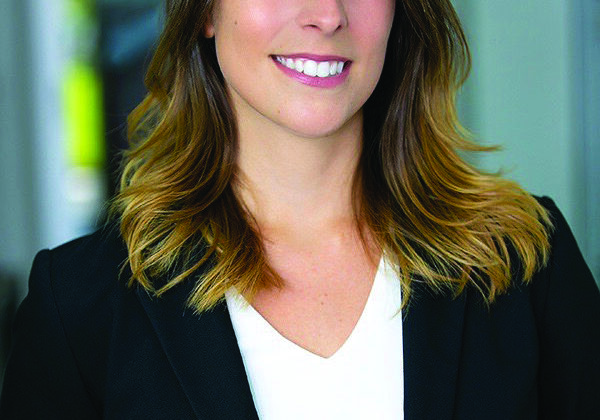ALUMS IN ACTION: Morgan Caswell ’06, Manager of Air Quality Practices for the Port of Long Beach, CA

An environmental science course at UConn sparked Morgan’s interest. She had always had a passion for the outdoors and was an inveterate hiker; here was a field where she could help to protect the world of nature she loved. It felt like a calling.
At UConn, as Morgan navigated the various disciplines comprising environmental science, she gravitated toward internships focused on air quality. She worked for the Eastern Highlands Health District and the CT Department of Energy and Environmental Protection. At the Air Management Bureau of DEEP, she became fascinated with how public policy is made. “We just copy California,” she was told. California was setting the most ambitious standards for auto emissions in the nation, pushing manufacturers to innovate and produce more fuel-efficient cars.
So, it made sense that after completing her B.S. in Environmental Science at UConn, Morgan moved to California, where she earned her Master’s in Environmental Health at the Fielding School of Public Health at UCLA. She graduated in the city ranked worst in the nation for ozone pollution and fifth worst for particle pollution. Why? Because of its ports.
Together, the Port of Los Angeles and the Port of Long Beach form the fifth busiest port facility in the world and the busiest in the Americas. 40% of U.S. imports come through these ports. According to an article in Calmatters.org by Rachel Beckers, “Moving goods from ship to truck to warehouse accounts for nearly a third of California’s economy, but about half of its air pollution. Much of the pollution affects disadvantaged communities and communities of color near ports, freeways and freight corridors,” resulting in disproportionate rates of asthma and other respiratory diseases and cancer.
Sources of emissions at the port are ocean-going cargo ships, harbor vessels, heavy-duty trucks, diesel locomotives, and cargo handling equipment. Geographical factors compound the problem. “Los Angeles is a natural pollution trap. The surrounding mountains combine with temperature inversions to trap dirty air.” (Sara Gardner, “Marketplace”) The area is a bowl in which 16 million people live and drive, coexisting with the two ports’ cargo moving vehicles. The solution must lie in cooperation between government and industry, with the use of cutting-edge technology.
As Manager of Air Quality Practices for the Port of Long Beach, Morgan works closely with the CA Air Resources Board, which sets regulations for port operations. Apart from government regulations, the two ports have voluntarily undertaken ambitious goals to improve air quality. Their guiding document for mitigation is the Clean Air Action Plan, instituted in 2006 and updated in 2010 and 2017. Morgan oversees the implementation of the Action Plan, guiding her team at the Port of Long Beach and serving as a liaison with community members and other involved entities and regulators.
In an interview with the Long Beach Business Journal, Morgan described the Community Grants Program, a more than $46 million voluntary investment in community projects focused on air and water quality, noise pollution, and traffic. Projects are based on the Port of Long Beach Community Impact Study, an analysis to determine the extent of environmental impact in surrounding neighborhoods. “We’re actually taking dollars and giving them to the community to perform the projects, and they weigh in on which projects they’d like to see, as well,” she said. “Annually, we do outreach to the community to understand what their priorities are for projects in the coming year, and I think that’s also pretty unique, having a grant funding program that’s really based on community input.”
The Port of Long Beach has set goals of zero emissions for cargo handling by 2030 and zero drayage truck emissions by 2035. Morgan manages $100 million in grants for near-zero and zero-emission vehicles, vessels, and infrastructure deployment. She implements clean vessel incentives and operational changes. And she administers the Clean Truck Program, which assesses a tariff on diesel trucks at the port and uses the funds to support zero-emission truck deployment.
Morgan points out that, while the whole world struggles with climate change, here is a targeted effort to address a serious local health issue. The Port of Long Beach has achieved 88% reduction in diesel soot, 49% reduction in nitrogen oxides, and 96% reduction in sulfur oxides in the past 17 years. Greenhouse gases, however, were up 22% last year because demand for materials jumped 40% during the COVID-19 pandemic. The many-pronged efforts of the Port of Long Beach are showing progress, but experimentation, monitoring, data-gathering, evaluation, and testing new methods are a long-term process, all managed by this talented Renbrook alum.
In her seven years at the Port of Long Beach, Morgan has found her work exciting and rewarding. Working toward practical solutions to environmental problems, she is constantly learning and using her communication skills. She sees tangible progress at the intersection of environmental science, social justice, and community health issues. Leading dialogue among citizens, government, manufacturers, and suppliers, Morgan fills a key role in making life better for workers and neighboring communities.